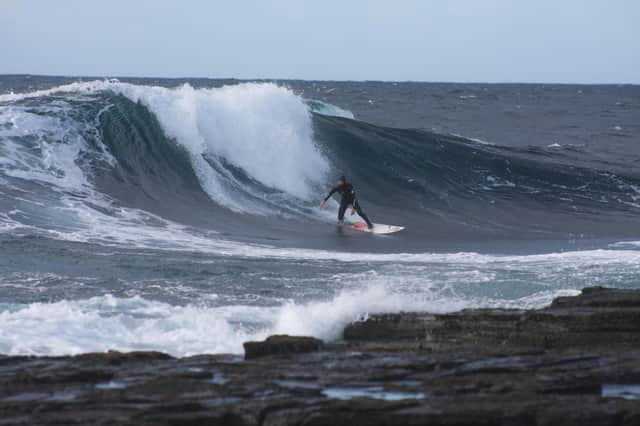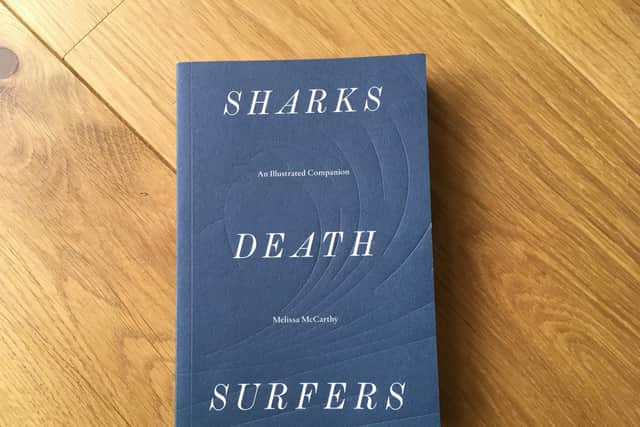Sharks Death Surfers: An Edinburgh writer offers some novel perspectives


About a year ago now, I bought a book called Sharks Death Surfers: An Illustrated Companion by the Edinburgh-based writer Melissa McCarthy. Published in a beautiful, understated pocket-sized edition by Sternberg press, in less than 150 pages, the blurb claimed, it would investigate “a fundamental aspect of the human condition: our state of being between life and death.” At first glance, the subtly embossed design on the cover looked like a barrelling wave as viewed by a surfer on the inside looking out, although thanks to the jagged lines running along its crest, the wave could also be read as the maw of a hungry shark.
Ordinarily I dive into new books straight away, but this one felt like something that needed to be read at a particular time and under particular conditions, so for many months it sat on my bedside table, slowly sinking further and further down the “to read” pile. At one point it was all set to come on holiday with me as one of a select group of books earmarked for Easter reading, but then lockdown happened and Easter was cancelled.
Advertisement
Hide AdAdvertisement
Hide AdI read the first few pages during lockdown but then stopped: trying to get my head around a book about surfing-related philosophy at a time when I wasn’t able to surf didn’t seem to make sense. A few days ago, however, no longer drydocked and with a few semi-satisfying summer surfs under my belt, I decided the time had come to crack the spine and find out what I’d been missing.


Intriguingly, McCarthy’s entire premise is based on what she describes as a “misdirection.” During an interview with Andy Martin, the former surfing correspondent of the Times, she explains she got the impression that Captain Cook’s final journal entry – written just before he was killed by angry Hawaiians – ended with the words “today I went surfing.” This turned out not to be the case: various crew members on board Cook’s ship wrote at length about witnessing Hawaiians surfing, but Cook himself didn’t mention surfing at all. However, McCarthy was so fascinated by Martin’s assertion that Cook’s famous voyages of discovery were ultimately “a journey toward surfing, that is, toward death” that she refused to let the truth stand in the way of an interesting idea and carried on regardless.
It’s a good thing she did, because Sharks Death Surfers is an intense and invigorating intellectual dance, albeit one that requires any prospective partner to be in an accommodating frame of mind. Rather than plodding along in a predictable, linear fashion towards a carefully argued conclusion, McCarthy’s book dots around between lots of apparently tenuously linked concepts and slowly draws them all together (sometimes neatly, sometimes messily) into a huge, interconnected web.
If the book can be said to have a central idea or motif, it is perhaps this: that a surfer riding a wave can be a useful symbol to think with. As McCarthy puts it: “Surfing has a particular sort of freedom, the special quality of being in a privileged relationship with the boundary. The surfer is not in the water, in the air, on dry land, but a little of all of these, all at once... The surfer understands that a boundary is not an impermeable, confining membrane, nor a simple signpost indicating a new state, but fundamentally an opportunity. It enables the surfer to slide along and enjoy the interface.”
This isn’t really the kind of book that answers questions, but the kind that asks them, and to try and summarise the myriad different directions in which McCarthy’s inquiring mind takes the reader in a space as small as this would be a fool’s errand. Suffice to say there are fascinating digressions into the world of newspaper obituaries, the way in which sharks perceive the world, the California surf photography of Ron Stoner and the differences between the cover of the original, hardback edition of Jaws and the more lurid paperback.
And for all that her chosen title might sound a little sensationalist (Sharks! Death! Surfers!) McCarthy never treats her chosen subjects anything less than seriously. In her conclusion, she writes: “Andy Martin thought it was a joke to be official surfing correspondent for the Times, because the two zones – surfing and the written rest of the world – are commonly held to be apart, without overlap, interplay, or traction on each other. But I don’t... If we only looked closely, it would be obvious that the world of surfing – edge, surface, movement, balance, shark, death, writing – is the proper, the very best place to be looking if we want to find out anything that matters.”
Sharks Death Surfers: An Illustrated Companion, by Melissa McCarthy, Sternberg Press, 151pp, £17.95
A message from the Editor
Thank you for reading this story on our website. While I have your attention, I also have an important request to make of you.
Advertisement
Hide AdAdvertisement
Hide AdThe dramatic events of 2020 are having a major impact on many of our advertisers - and consequently the revenue we receive. We are now more reliant than ever on you taking out a digital subscription to support our journalism.
To subscribe to scotsman.com and enjoy unlimited access to Scottish news and information online and on our app, visit https://www.scotsman.com/subscriptions
Joy Yates, Editorial Director